Giochi dell'Oca e di percorso
(by Luigi Ciompi & Adrian Seville)
(by Luigi Ciompi & Adrian Seville)

|
Giochi dell'Oca e di percorso
(by Luigi Ciompi & Adrian Seville) |

|
 |

Torna alla ricerca giochi (back to game search) |
 |
| Giocco Del Pela Il Chiv | ||
 |
Versione stampabile
 |
Invia una segnalazione

|
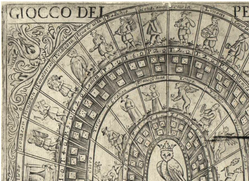 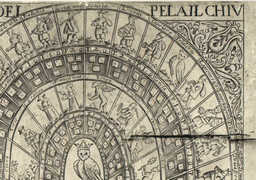 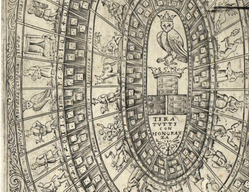  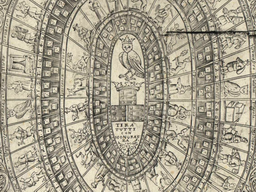 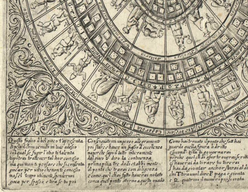  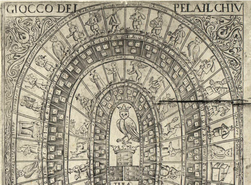 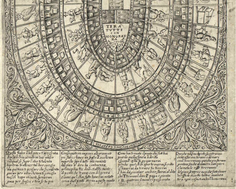 |
primo autore: | Anonimo |
| secondo autore: | Salvadori Angelo | |
| anno: | 1616/37 | |
| luogo: |
Italia-Venezia |
|
| periodo: | XVII secolo (1°-2°/4) | |
| percorso: | Gioco con i dadi | |
| materiale: | carta (paper) (papier) | |
| dimensioni: | 280X196 | |
| stampa: | Stampa su legno (bois gravé) (woodcut) | |
| luogo acquisto: | ||
| data acquisto: | ||
| dimensioni confezione: | ||
| numero caselle: | 56 | |
| categoria: | Lotterie, fortuna, gioco d'azzardo | |
| tipo di gioco: | Gioco con i dadi | |
| editore: | Salvadori Angelo | |
| stampatore: | Salvadori Angelo | |
| proprietario: | MAK Wien, Museum (Österreichisches Museum für angewandte Kunst) | |
| autore delle foto: | MAK Wien, Museum | |
| numero di catalogo: | 2527 | |
| descrizione: |
Gioco di 56 caselle non numerate disposte in due ellissi (ovati). Ogni casella presenta una figura ed una combinazione di dadi. Le combinazioni vincenti o perdenti sono indicate con le sigle P (paga), T (tira). La sigla Q (quattrini) indica la posta da pagare o tirare. Il nome del gioco significa "spennare la civetta" e consiste nel lanciare tre dadi e raggiungere la posizione che corrisponde al lancio sull'ovale interno o esterno, per poi eseguire le istruzioni scritte: 'T' significa tira per prendere il numero di quattrini ('Q') indicato; 'P' significa paga. Un tiro di tre sei (raffa 6.6.6.) prende tutto. Al centro: raffa di 6: "Tira Tutti con Honoranza". REGOLE: in basso. "Questo foglio il bel gioco t'apresenta / di pela il chiu venuto in luce adesso / col quale se fugir l'otio ti talenta / ti potrai trattener tal hor con esso / ma qui non ti pensare che si consenta / giocar per vitio che non te concesso / ma sel tempo utilmente spender voi / gioca per spasso e tira se tu poi / Con sei quatrini un pezzo allegramente / poi stare e havere un spasso d'eccellenza / ma perchè sapi il tutto intieramente / del gioco te diro la continenza / prima pilia tre dadi et abbi mente / al ponto che trarai con diligenza / e come quel ch'ai fatto haverai notato / cerca quel ponto atorno a questo ovado / Come hai trovato il ponto che fatt hai / guarda quella figura li dritto / e seconda questa ti governarai / perchè quel ch'ai afar troverai scritto / s'haverai da tirare tu tirerai / s'hai da giontar anchor starai al dito / Chi T tira vuol dire P paga o gionta / e Q quatrini il numero poi si conta / Quei che nel fine il ponto scontranno / come a farina (vedi Nota 2) tirano i denari / con l'honoranza e quei che piu farano / giontano fin che al numero sian pari / e la meta le riffe tireranno / del gioco sempre, e accio che sian chiare / la riffa de diciotto laltre avanza / tira ogni cosa et ancho l'honoranza." This sheet presents you with the beautiful game of "Pluck the Owl" which has now come to light with which, if you like to escape from idleness, you can sometimes entertain yourself. But here (in this game) don't think that it is permitted to play for vice because it is not allowed to you. But if you want to spend the time usefully play for fun and if you can, roll (the dice). With six coins (quattrini) you can merrily stay a little and have excellent entertainment. But so that you know everything, I'll tell you the content of the game. First take three dice and diligently (carefully) remember the point (combination) you make. And when you have noted the point that you made, look for that point in this oval. Once you have found the point (the combination) that you have made, look at that figure and act accordingly because you will find written what you have to do; and if you have to take, you will take (from the pool). If you have to add, you will do as indicated; who (obtains) T means takes (withdraws), P pays or adds and Q coins (quattrini) the number is counted later. Those who in the end find the point, as at Farina (see NOTA 2) take the coins, with the honoranza. And those who would play on must add in equal numbers. And the "riffa" (combinations of 3 equal numbers) will take half. For clarity, in the game the "riffa" of eighteen (combination of three 6) it surpasses the others throws and takes everything and also the "honoranza". CASELLE: con combinazioni di dadi. Ellissi esterna (in senso antiorario): LIMONI: T.2.Q. (1,6,2); SEMOLA: T.2.Q. (4,3,5); SCOVACAMIN: P.2.Q. (5,4,4); RADICHIO: T.6.Q. (2,2,6); AQUA DE VITA: P.1.Q (4,4,2); PELALCHIU: LA META (1,1,1); PANATARIO: T.2.Q. (5,5,3,); VENTOLETI: P.3.Q. (4,3,3); SCOVAZER: T.4.Q. (3,5,3); IL LETTO: T.1.Q. (3,2,1); CINGANA: P.5.Q. (3,3,2); ONORANZA: TUTTI (6,6,6); INGYTERREGOTTI: T.1.Q. (1,3,6); BULLO: T.2.Q. (4,4,5); TAIA LEGNE: T.2.Q. (5,1,6,); L'ORBO: T.1.Q. (6,3,3); MATTO: NULLA (3,6,6); PELALCHIU: LA META (5,5,5); LA BORTOLAN: T.3.Q. (4,2,6); CAGAROLA: P.4.Q. (1,1,6); AZE BRESANE: P.2.Q. (4,1,4); CONZA LANEZI: P.4.Q. (2,2,4); COCCHIO: P.2.Q. (2,1,2); PELACHIU: LA META (4,4,4); BOZOLA ..: T.1.Q. (2,2,3); RVFIANA: P.8.Q. (2,2,5); CANDELARO: T.2.Q. (2,2,6); MOLINARO: T.1.Q. (1,4,5); TRAPOLA: P.6.Q. (1,1,2); PELALCHIV: LA META (3,3,3); STRAZAFERO: P.2.Q. (1,1,3); PETENAR: P.1.Q. (1,1,5); LA MORTE DI SORZI: P.3.Q. (1,1,5); LA PREMORASA: P.1.Q. (2,1,4); PELALCHIU: LA META (2,2,2); CAPELARO: P.1.Q. (3,6,5); Ellissi interna (in senso antiorario): IL TEMPO: T.3.Q. (5,4,5); FRANCESCHINA: T.2.Q. (5,1,5); GRATIAN: T.1.Q. (3,3,1); TIRSE: T.2.Q. (2.5,5); CLORO: T.1.Q. (5,5,3); IGNORANZA: P.12.Q. (5,6,4); TODESCHO: T.2.Q. (3,3,4); IL BABUIN: P.3.Q. (4,6,1); BARBARO: T.4.Q. (4,4,3); NEGROMANTE: T.6.Q. (6,6,4); SALTARIA: T.2.Q. (6,5,6); STROLOGO: P.2.Q. (4,4,6); FRANCHATRIPA: T.2. Q. (6,4,3); CARDON: T.2.Q. (6,1,6); PEDROLIN: T.2.Q. (5,6,2); BACHO: T.6.Q. (6,5,3); PANTALONE: T.3.Q. (6,3,1); SATIRO: T.1.Q. (2,6,6); CVPIDO: P.6.Q. (5,6,5); TRASTVLO: T.1.Q. (4,3,2); NOTA 1: questo esemplare di Angelo Salvadori è una riedizione reimpostata di un gioco con stessa tipologia realizzato verso la fine del '500 a Roma da Ambrogio Brambilla (vedi Referenza 2 e Arch. n°448). Insieme ad altri cinque giochi conservati al "MAK Museum" di Vienna rappresenta la riedizione veneziana di giochi già realizzati da editori romani. Il Salvadori fu attivo dal 1616 al 1630 con la denominazione "Libraro à S. Moisè" e dal 1633 al 1637 come "Libraro in Frezzaria". NOTA 2 La Farina was a dice game, with a similar rule, that a given throw took all the stakes. Dadi da farina (dice for farina) are mentioned in Citolini’s Tipocosmia of 1561. These dice are called farinacci (Spanish: harinillas) and their nature is specified in a Spanish-Italian dictionary of 1638: Harinillas: si chiamano "I farinacci", cioé i sei dadi segnati da una banda sola and further clarified in another dictionary of the time: A kind of Italian dye (die): Farinacci, sono sei dadi segnato ciascuno solamente d’un punto; six dez marquez seulement d’un point, fort usitez en Italie. [six dice marked only on one face, much used in Italy]. Another Italian game of three dice, Carica l’Asino (Load the Donkey) has a more explicit reference in its rules to the Farina game: Il gioco e simile a quello da Farina perché finché non si fa il punto che leva tutti i denari non si puo finire. [The game is like that of Farina because it does not finish unless the point is made that takes all the money]. Of this game, Alberto Milano writes that the oldest example is that published by Giovanni Antonio De Paoli at Rome in 1590, thus almost contemporary with the Brambilla game. Ulrich Schädler has clarified that the game of Farina is the same as the game of Schimmel. He notes that a [later] Italian-German dictionary has the entry: “Giuocare a farina oder a farinacci = Schimmeln” Schimmel is played with six dice, each having only a single face marked with a number, the numbers running from 1 to 6. An all-white throw (no number showing) is called Schimmel (white horse) and no doubt the Italian version got its name, meaning "flour", from such a throw. To finish the game, a throw is required where the sum of numbers showing is exactly the number of stakes in the pool. (Adrian Seville) REFERENZA 1 "Gioco del Pela il Chiù", MAK Museum Vienna REFERENZA 2 Il Piacevole e Nuovo Giuoco Novamente Trovato Detto Pela il Chiù. Incisione in rame, 404X523 mm. Roma inizio del XVII secolo. Ambrogio Brambilla incise la matrice in rame nel 1589 per l'editore Giovan Battista di Lazzaro Panzera di Parma, attivo a Roma negli ultimi anni del Cinquecento (cfr. un esemplare della tiratura originale conservato al British Museum, REG. 1869,0410.2460). Il rame venne poi ristampato durante tutto il Seicento dai De Rossi a Roma, che tolsero il nome di Panzera ma lasciarono il monogramma di Brambilla. Il gioco inventato da Brambilla fu copiato subito da altri editori italiani e servì da modello per la produzione sei-settecentesca italiana del Gioco del Pela il Chiù. Di conseguenza tutte le caselle relative alle diverse combinazioni che danno luogo a vincite e perdite rimasero fondamentalmente le stesse, con poche varianti. (Alberto Milano) |
|
| bibliografia: |
1) CITOLINI, Alessandro: "La tipocosmia di Alessandro Citolini, da Serraualle". In Venetia: appresso Vincenzo Valgrisi, 1561, p. 484. 2) FRANCIOSINI,Lorenzo: "Vocabulario español e italiano", Volume 2 Roma: en la Emprenta de la Reu. Camera Apostolica, 1638, p. 428. 3) LA MARINIERE, de: "La Maison Academique: contenant un recueil general de tous les jeux divertissans pour se rejouyr agreablement dans les bonnes compagnies", par le sieur D.L.M. [de La Marinière]. A Paris: chez Robert de Nain et Marin Leché, M.DC.LIV 4) HOWELL, James: Lexicon tetraglotton, an English-French-Italian-Spanish dictionary. London: by J.G. for Samuel Thomson, 1660, p. 532. 5) VINCK, Eugène, Baron de: "Iconographie du Noble Jeu de l’Oye. Catalogue descriptif et raisonné de la Collection de Jeux formé par le Baron de Vinck". 126 Jeux du XVIIIe au débùt du XIXe siècle. FR. J. Olivier Libraire, 11 Rue des Paroissiens, Bruxelles, 1886. 6) D’ALLEMAGNE, H. R. : "Le Noble Jeu de l’Oie", Paris, Libraire Gruend, 1950. 7) NEGRI, Ilio – VERCELLONI, Virgilio: "I Giochi di Dadi d’Azzardo e di Passatempo dei Gentiluomini e dei Pirati" Introduzione di Caterina Santoro, Lerici Milano, 1958. 8) VON WILCKENS, L. : "Spiel, Spiele, Kinderspiel (exhibition catalogue)", Germanisches Nationalmuseums, Nuernberg, 1985. 9) Catalogo Mostra: "Costume e società nei giochi a stampa di Giuseppe Maria Mitelli", Electa Editori Umbri Associati 1988. 10) BERTI, Giordano - VITALI, Andrea: “La vite e il vino. Carte da gioco e giochi di carta”, Fondazione Lungarotti, Edigraf, Roma 1999. 11) BURY, Michael: “The Print in Italy: 1550-1620”, BM 2001. 12) BUIJNSTERS, P.J. and Buijnsters-Smets,L. : "Papertoys", Zwolle, Waanders, 2005. 13) PLOCK, Phillippa - SEVILLE, Adrian: "The Rothschild Collection of printed board games at Waddesdon Manor", in XIIIth Board Game Studies Colloquium, Paris, 14-17 April 2010. 14) DEPAULIS, Thierry: “Trois jeux imprimés du début du XVIIe siècle par la veuve Petit à Paris”, Arbeitskreis Bild Druck Papier , Band 16 2011 15) MILANO, Alberto: "Giochi da salotto. Giochi da osteria, nella vita milanese dal Cinquecento all'Ottocento". Edizioni Gabriele Mazzotta, Milano 2012. 16) DEPAULIS, Thierry: "Three early 17th-century printed games by the Veuve Petit in Paris". In: Of Boards and Men: Board Games Investigated. Proceedings of the XIIIth Board Game Studies Colloquium, Paris, 14-17 April 2010, collected and edited by "Thierry Depaulis", [Paris], 2012, p. 75-89. 17) DEPAULIS, Thierry: "Vaugeois, tabletier, connu et inconnu" (2e partie). Le Vieux Papier fasc. n°422, 2016. 18) PARLAK, Ömer Fatih: "The Image of the Turk in Early Modern Board Games and Playing Cards". PHD THESIS. Universitat Autonoma de Barcelona, 2019. 19) SEVILLE, Adrian: "The Game of the Owl". In: "Vieux Papier", Aprile - Giugno 2021. 20) MAK Wien, Museum |
|
Vai alla ricerca giochi Vai all'elenco autori